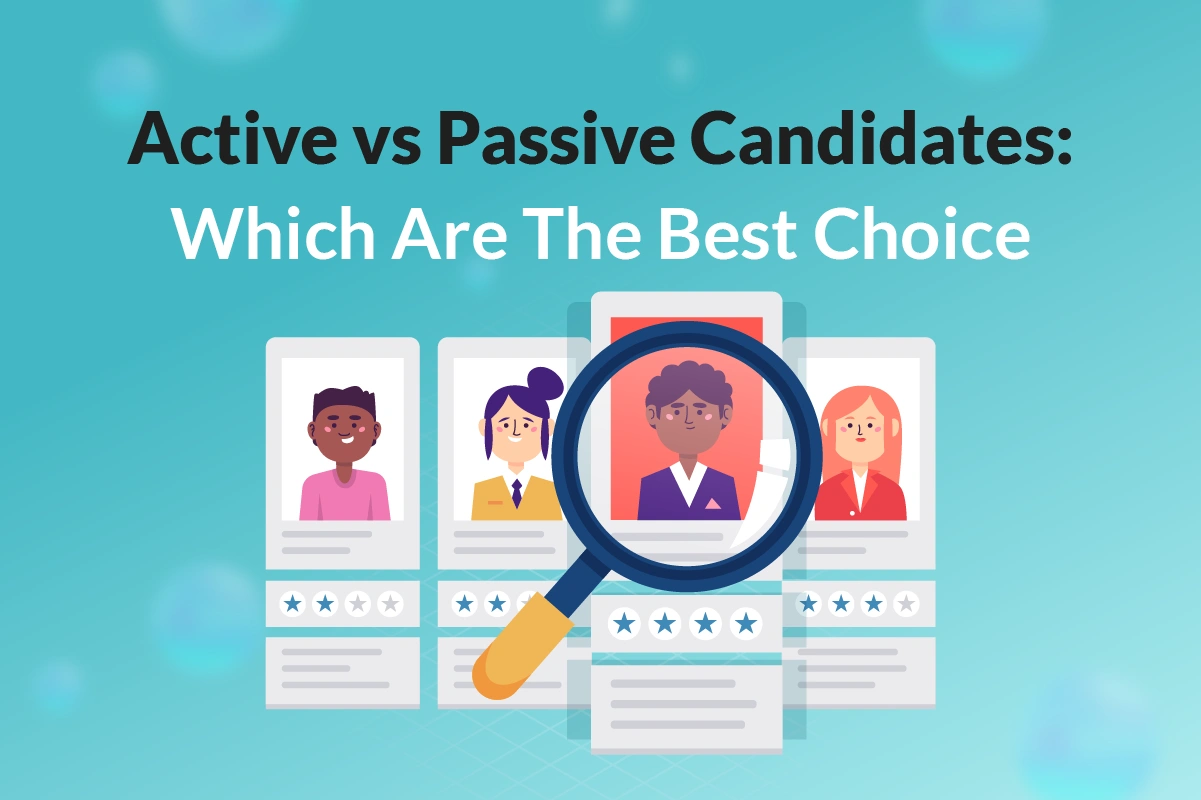When it comes to talent acquisition, understanding the differences between active and passive candidates is essential to make the best hiring decisions. So who should recruiters focus on: active or passive candidates?
There’s no clear-cut answer here – active candidates will always be a central part of the recruiting process, but you should also consider the ones that aren’t applying. Join us to explore each group to help your business make the best talent acquisition strategies.
What Are Active Candidates?

Active candidates are those who are actively seeking employment. They have updated their resume regularly and posted it. They keep track of job postings on numerous job boards and are in contact with headhunters.
→ Have a look at our newly-updated Job Board.
An active candidate does not necessarily mean unemployed. This group may be seeking a new opportunity for several reasons:
- They are worried about the stability of their existing employment.
- They want to assume greater responsibility
- They look for better compensation and benefits.
- They are misaligned with the current company culture and values
According to research by LinkedIn, this group makes up around 25% of the fully employed workforce, and it is from this group that most hires are made That’s because passive candidates are t actively looking for their next job and are agressive about pursuing new opportunities.
What Are Passive Candidates?

Passive candidates aren’t actively looking for new employment. They often have jobs and are committed to them. However, this doesn’t mean passive candidates are always disinterested in other opportunities. They can be open to other jobs if they see a value they don’t receive from their existing positions.
However, unlike active applicants, passive candidates do not proactively apply for new positions. Instead, they don’t often update their resumes, but do seeknew contacts, and network within their sector using social networking networks like LinkedIn.
Active vs Passive Candidates: 10 Key Differences

Want more details on how passive candidates and active candidates differ from each other? Here are10 key differences that sheds light on their motivations, availability, responsiveness, and suitability for various hiring needs.
|
Criteria |
Active Candidates |
Passive Candidates |
|
Job Search Status |
Actively seeking employment opportunities |
Not actively seeking employment |
|
Intent and Motivation |
Highly motivated for career advancement |
Less motivated, open to new possibilities |
|
Engagement in the Job Market |
Actively involved in job market |
Less involved, maintain passive presence |
|
Availability |
Available for immediate hiring |
May have longer notice periods |
|
Skill Set and Experience |
Focused on maitaining relevancy |
Deep knowledge in their current field |
|
Compensation Expectations |
May be open to matching last /current salary |
Will typically need a higher salary to make a switch |
|
Industry Knowledge |
Stays updated with trends and developments |
Relies on prior experiences or on the job training |
|
Networking and Referrals |
Actively networks with professionals |
Limited networking, strong internal network |
|
Recruitment Approach |
Proactive recruitment strategy |
Focused and customized approach |
|
Time and Resource Investment |
Less time and resources required |
More time and resources may be needed |
|
Importance of Employer Branding |
Research and evaluate potential employers but mostly responds to job descriptions |
Less active research until approached so will rely on employer branding to confirm fit |
Job Search Status
Active candidates are actively searching for new job opportunities. They proactively engage in the job market, searching for openings and sending out applications and resumes regularly.
Passive candidates are not actively seeking employment. Typically, they are employed and content with their present situation. However, this does not imply that they are totally closed off to new possibilities. Passive candidates may consider a job change if the right opportunity comes along.
Intent and Motivation
Active job seekers are very driven to get a new position. They could be motivated by various things, such as a better work-life balance, job promotion, greater pay, or a desire for change.
Passive candidates may be less motivated to pursue new opportunities actively. This does not mean that they are uninterested or lack ambition. It is vital to give these passive candidates strong-enough incentives or compelling reasons to consider leaving their current position.
Engagement in the Job Market
Active job seekers keep current on market trends, vacancies, and networking opportunities. They actively look for possibilities to improve their job prospects and use various platforms and channels to demonstrate their abilities.
Otherwise, passive candidates are less involved in the job market as they are not actively seeking new employment. Despite having limited exposure to industry events or networking opportunities, they might still maintain a passive online presence, such as a LinkedIn profile, to showcase their professional background and stay connected with their industry peers.
Availability for Immediate Hiring
Active individuals are often available for employment right away. They are actively seeking a change of scenery, and if the perfect opportunity presents itself, they are prepared to get immediately into the onboarding process. Their accessibility matches the urgency of employment needs, making them appropriate for businesses seeking immediate workforce additions.
The recruiting process could take longer with passive candidates. As they are not actively seeking new employment, they may have more extended notice periods or commitments to their current employers. Negotiating start dates and considering notice periods may be necessary to persuade passive candidates to quit their existing positions and join a new company.
Skill Set and Experience
Continually honing diverse skills and experience is a big plus for active candidates. To catch the eyes of employers and land their dream jobs, active candidates try to embellish their resumes with recent training or certifications that make them relevant and up-to-date in their field.
Unlike active candidates, passive candidates focus on developing their niche, which is forged during their long careers. Passive candidates often bring stability, consistency, and deep knowledge in their respective fields.
Compensation Expectations

Active candidates are more likely to be okay with a salary match if other benefits match their needs . They are actively looking for better professional opportunitiesand can be open to changing jobs in exchange for a raise in pay, management opportunity, flexibility, better benefits, or other bonuses.
Passive candidates will need a greater incentive to leave a company where they have been rewarded and provides stability. Since they aren’t actively seeking new chances, they could need more alluring offers before considering changing jobs. To recruit passive candidates, employers must carefully consider and propose appealing packages.
Industry Knowledge
Candidates seeking employment keep up with trends, developments, and changes in their field. They participate in professional forums, attend pertinent webinars or seminars, and actively interact with specialized knowledge.
On the other hand, passive candidates may not be as current with emerging trends or innovations while having a solid basis in industry expertise. They often depend on their prior experiences. However, they are still open to acquiring new knowledge and adapting to changes if they pursue new opportunities.
Networking and Referrals
Active candidates are aware of the significance of networking and actively create contacts within their sector. They actively participate in networking events, keep in touch with coworkers and other professionals in the field, and look for mentors or advisers.
Due to their focus on their present employment, passive candidates may not have made as much of an attempt to network. However, they could have developed a substantial network inside their present company or sector over time. Recruiters should use their network by using recommendations from colleagues or friends who can attest to the talents and potential of the passive candidates.
Recruitment Approach

A proactive strategy is often used in recruiting active applicants. Employers may reach out to interested applicants via recruiting firms or career portals, aggressively market job opportunities, and publish on job boards.
Attracting passive candidates calls for a more focused and convincing strategy. Employers must contact them with a customized strategy and emphasize the advantages and prospects of the role.
Time and Resource Investment
It generally takes less time and money to recruit active candidates. They are more receptive to contact, quick in supplying requested papers, and easily accessible for interviews or evaluations since they are actively looking for new possibilities.
Recruiting passive candidates can be a more time-consuming and resource-intensive process. Employers must take the time to locate and interact with prospective passive candidates. Establishing rapport and trust while addressing their concerns and questions could require extra work.
Employer Branding
Active candidates actively research and evaluate potential employers. Employers with a strong employer brand and positive reputation are more likely to attract active candidates who actively seek desirable work environments.
Passive candidates may not actively research potential employers until they are approached with an opportunity. However, a strong employer brand and positive reputation can create a positive impression and influence passive candidates’ interest in considering a job change.
Which Type Fits Your Hiring Needs? Active or Passive Candidates?

There is no one-size-fits-all answer for whether passive vs active candidates are a better match.
Consider the following:
Active candidates could be a good fit if:
- You have an urgent need to fill a position quickly.
- You require candidates with specific skills or stay up-to-date knowledge of industry trends.
- You value candidates who take the initiative and proactively engage in their job search.
- You need a short and less time-consuming recruitment process.
Passive candidates may be appropriate if:
- You seek candidates with in-depth knowledge or highly specialized skills in a specific field.
- You have future hiring needs or seek candidates who can contribute to your organization’s long-term growth.
- The role demands specific skills that may not be readily available among active candidates.
The choice between active and passive applicants ultimately comes down to your hiring timeframe, needs, objectives, and recruiting resources. It is also essential to assess each applicant based on their fit with your organization’s culture and values.
Conclusion
Remember that employer branding is crucial in attracting active vs passive candidates. While active candidates actively research and evaluate employer brands, passive candidates may require targeted employer branding efforts to capture their attention and showcase the organization’s values, culture, and opportunities. Effective employer branding can differentiate an organization from competitors, making it more appealing to active and passive candidates.
Find it challenging to attract candidates? Boulo Solutions can help you find and hire the individuals that suit your requirements and culture. Post A Job and start finding top talent!

